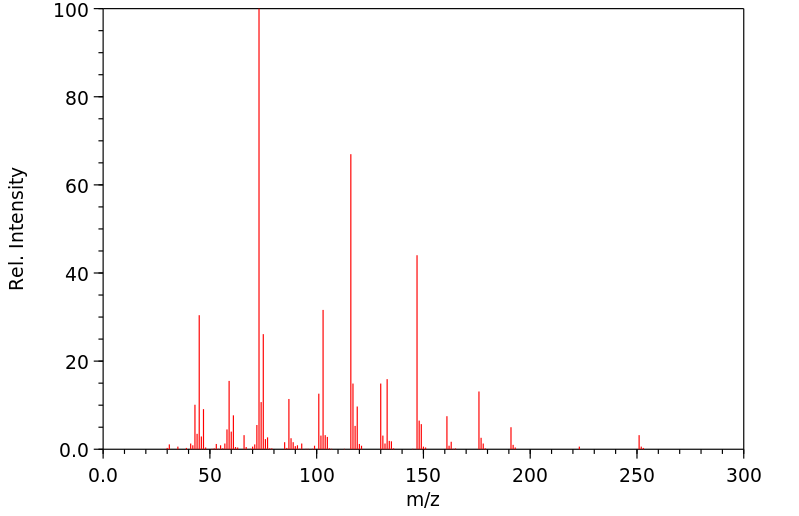bis(2-trimethylsiloxyethyl)sulfide | 20486-03-7
中文名称
——
中文别名
——
英文名称
bis(2-trimethylsiloxyethyl)sulfide
英文别名
Bis(trimethylsilyl)thiodiglycol;trimethyl-[2-(2-trimethylsilyloxyethylsulfanyl)ethoxy]silane
CAS
20486-03-7
化学式
C10H26O2SSi2
mdl
——
分子量
266.552
InChiKey
DTZWCELPJYGDPE-UHFFFAOYSA-N
BEILSTEIN
——
EINECS
——
-
物化性质
-
计算性质
-
ADMET
-
安全信息
-
SDS
-
制备方法与用途
-
上下游信息
-
文献信息
-
表征谱图
-
同类化合物
-
相关功能分类
-
相关结构分类
物化性质
-
沸点:269 °C
-
密度:0.9552 g/cm3
-
保留指数:1427;1427;1424.8;1425.4
计算性质
-
辛醇/水分配系数(LogP):3.42
-
重原子数:15
-
可旋转键数:8
-
环数:0.0
-
sp3杂化的碳原子比例:1.0
-
拓扑面积:43.8
-
氢给体数:0
-
氢受体数:3
反应信息
-
作为反应物:描述:参考文献:名称:Intramolecular base-stabilised adducts of main group halides摘要:烷氧基和氨基配体的配位化学已发展到包括主族配合物实例在内的氮或硫给体。研究了 13 和 14 族衍生物{[6-(Me3SiN)-2-Me-C5H3N]SnCl3 和[6-(Me3SiN)-2-Me-C5H3N]BBr2}通过系链吡啶基增强氨基配体配位的结构含义。此外,还深入研究了由三甲基硅取代前体合成烷氧基和氨基衍生物的范围、动力学和机理。研究发现,该方法适用于一系列由一个或两个 "系 "臂稳定的具有不同灵活性的配体框架。DOI:10.1039/b110692a
-
作为产物:描述:参考文献:名称:Intramolecular base-stabilised adducts of main group halides摘要:烷氧基和氨基配体的配位化学已发展到包括主族配合物实例在内的氮或硫给体。研究了 13 和 14 族衍生物{[6-(Me3SiN)-2-Me-C5H3N]SnCl3 和[6-(Me3SiN)-2-Me-C5H3N]BBr2}通过系链吡啶基增强氨基配体配位的结构含义。此外,还深入研究了由三甲基硅取代前体合成烷氧基和氨基衍生物的范围、动力学和机理。研究发现,该方法适用于一系列由一个或两个 "系 "臂稳定的具有不同灵活性的配体框架。DOI:10.1039/b110692a
文献信息
-
The formation of alkoxysilanes from the interaction of linear and cyclic thiosilanes and disilthianes with oxygen heterocyclic rings作者:E. W. Abel、D. J. WalkerDOI:10.1039/j19680002338日期:——Ethylene oxide, propene oxide, cyclohexene oxide, trimethylene oxide, and tetrahydrofuran react with a variety of linear and cyclic silicon–sulphur compounds to produce a range of monomeric and polymeric alkoxysilanes. β-Propiolactone undergoes alkyl–oxygen fission to insert into silicon–sulphur bonds.
-
Determination of Mustard Gas Hydrolysis Products Thiodiglycol and Thiodiglycol Sulfoxide by Gas Chromatography-Tandem Mass Spectrometry after Trifluoroacetylation作者:Stanisław Popiel、Jakub Nawała、Daniel Dziedzic、Martin Söderström、Paula VanninenDOI:10.1021/ac500656g日期:2014.6.17A method for detecting mustard gas degradation products thiodiglycol (TDG) and thiodiglycol sulfoxide (TDGO) in water and sediment samples using gas chromatography-tandem mass spectrometry (GC-MS/MS) after derivatization with 1-(trifluoroacetyl)imidazole (TFAI) was described. Selected reaction monitoring mode (SRM) of tandem mass spectrometry was developed for analysis of TDG and TDGO derivatives while analysis by gas chromatography-atomic emission detector (GC-AED) was performed using the 181 nm sulfur canal. TFAI derivatization conditions were optimized and the method validated. Two derivatization agents were compared, TFAI and N,O-bis(trimethylsilyl) trifluoroacetamide (BSTFA), where derivatization using TFAI occurred quicker and under milder conditions than using BSTFA. Water samples containing TDG and TDGO were evaporated to dryness under nitrogen, dissolved in organic solvent followed by reaction with TFAI. The limit of detection (LOD) for TDG and TDGO were 0.01 and 5 ng/mL, respectively. The limit of detection for TDG was decreased by two orders of magnitude if TFAI is used for derivatization rather than silyl derivatizing agents (e.g., BSTFA). TFAI has three major advantages in comparison to BSTFA, the first is much higher sensitvity, the second is a very clean background of chromatograms, and the last one is very mild conditions of derivatization. Moreover, by-products are not formed during derivatization of TDGO by TFAI in comparison to derivatization by silylating agents.介绍了一种利用 1-(三氟乙酰基)咪唑 (TFAI) 衍生后的气相色谱-串联质谱 (GC-MS/MS) 检测水和沉积物样品中芥子气降解产物硫代二甘醇 (TDG) 和硫代二甘醇亚砜 (TDGO) 的方法。开发了用于分析 TDG 和 TDGO 衍生物的串联质谱选择反应监测模式(SRM),而气相色谱-原子发射检测器(GC-AED)则使用 181 nm 的硫管进行分析。对 TFAI 衍生条件进行了优化,并对方法进行了验证。比较了两种衍生剂,即 TFAI 和 N,O-双(三甲基硅基)三氟乙酰胺(BSTFA),使用 TFAI 衍生比使用 BSTFA 衍生更快,条件更温和。含有 TDG 和 TDGO 的水样在氮气下蒸发至干,溶解在有机溶剂中,然后与 TFAI 反应。TDG 和 TDGO 的检测限(LOD)分别为 0.01 和 5 纳克/毫升。如果使用 TFAI 而不是硅烷衍生剂(如 BSTFA)进行衍生,TDG 的检测限会降低两个数量级。与 BSTFA 相比,TFAI 有三大优势:首先是灵敏度更高,其次是色谱背景非常干净,最后是衍生条件非常温和。此外,与使用硅烷化剂进行衍生相比,使用 TFAI 对 TDGO 进行衍生时不会产生副产品。
-
Robert, Dominique; Gawad, Hoda Abdel; Riess, Jean G., Bulletin de la Societe Chimique de France, 1987, # 3, p. 511 - 516作者:Robert, Dominique、Gawad, Hoda Abdel、Riess, Jean G.DOI:——日期:——
-
Krolevets, A. A.; Antipova, V. V.; Popov, A. G., Journal of general chemistry of the USSR, 1988, vol. 58, # 10, p. 2023 - 2030作者:Krolevets, A. A.、Antipova, V. V.、Popov, A. G.、Adamov, A. V.DOI:——日期:——
-
New heterosilocanes, 1,1-difluoroand 1-phenyl-1-fluoro-2,8-dioxa-5-chalcogenosilocanes作者:M. G. Voronkov、O. M. Trofimova、E. A. Grebneva、A. I. Albanov、T. N. Aksamentova、N. N. Chipanina、A. S. SoldatenkoDOI:10.1134/s1070363210070108日期:2010.7The earlier unknown Si-fluorinated 2,8-dioxa-5-chalcogenosilocanes RFSi(OCH(2)CH(2))(2)Y (R = Ph, F; Y = O, S) were synthesized. According to calculations, there is a weak transannular coordinate interaction Y -> Si (Y = O, S), which is much weaker than that in the isostructural quasisilatranes (Y = N). At low temperatures, 1,1-difluoro-2,5,8-trioxasilocane forms a dimer, in which two molecules of the monomer are linked by four fluorine bridges Si-F -> Si located in pairs in the two orthogonal planes SiF(2)Si.
表征谱图
-
氢谱1HNMR
-
质谱MS
-
碳谱13CNMR
-
红外IR
-
拉曼Raman
-
峰位数据
-
峰位匹配
-
表征信息
同类化合物
(2-溴乙氧基)-特丁基二甲基硅烷
鲸蜡基聚二甲基硅氧烷
骨化醇杂质DCP
马沙骨化醇中间体
马来酸双(三甲硅烷)酯
顺式-二氯二(二甲基硒醚)铂(II)
顺-N-(1-(2-乙氧基乙基)-3-甲基-4-哌啶基)-N-苯基苯酰胺
降钙素杂质13
降冰片烯基乙基三甲氧基硅烷
降冰片烯基乙基-POSS
间-氨基苯基三甲氧基硅烷
镓,二(1,1-二甲基乙基)甲基-
镁,氯[[二甲基(1-甲基乙氧基)甲硅烷基]甲基]-
锑,二溴三丁基-
铷,[三(三甲基甲硅烷基)甲基]-
铂(0)-1,3-二乙烯-1,1,3,3-四甲基二硅氧烷
钾(4-{[二甲基(2-甲基-2-丙基)硅烷基]氧基}-1-丁炔-1-基)(三氟)硼酸酯(1-)
金刚烷基乙基三氯硅烷
酰氧基丙基双封头
达格列净杂质
辛醛,8-[[(1,1-二甲基乙基)二甲基甲硅烷基]氧代]-
辛甲基-1,4-二氧杂-2,3,5,6-四硅杂环己烷
辛基铵甲烷砷酸盐
辛基衍生化硅胶(C8)ZORBAX?LP100/40C8
辛基硅三醇
辛基甲基二乙氧基硅烷
辛基三甲氧基硅烷
辛基三氯硅烷
辛基(三苯基)硅烷
辛乙基三硅氧烷
路易氏剂-3
路易氏剂-2
路易士剂
试剂Cyanomethyl[3-(trimethoxysilyl)propyl]trithiocarbonate
试剂3-[Tris(trimethylsiloxy)silyl]propylvinylcarbamate
试剂3-(Trimethoxysilyl)propylvinylcarbamate
试剂2-(Trimethylsilyl)cyclopent-2-en-1-one
试剂11-Azidoundecyltriethoxysilane
西甲硅油杂质14
衣康酸二(三甲基硅基)酯
苯胺,4-[2-(三乙氧基甲硅烷基)乙基]-
苯磺酸,羟基-,盐,单钠聚合甲醛,1,3,5-三嗪-2,4,6-三胺和脲
苯甲醇,a-[(三苯代甲硅烷基)甲基]-
苯并磷杂硅杂英,5,10-二氢-10,10-二甲基-5-苯基-
苯基二甲基氯硅烷
苯基二甲基乙氧基硅
苯基二甲基(2'-甲氧基乙氧基)硅烷
苯基乙酰氧基三甲基硅烷
苯基三辛基硅烷
苯基三甲氧基硅烷







